Look! A star has fallen!
- Yes, straight into the Ursa Major Dipper...
- I wonder what’s there in this stellar Bucket?.. If only I could grab its Handle and look there!
- Maybe we can try?
The sky above us is like an ancient book, preserving the wisdom of centuries. Every night, as soon as the sun goes down below the horizon, this Heavenly Book opens, and its luminous star writings can tell a lot about the times when people performed feats, legends were made about heroes, and gods walked the earth...
Many legends are recorded in the great Book of the Starry Sky, and the brightest of them are associated with the most ancient constellations. Ursa Major is one of these constellations. This is no coincidence. To this day, the seven stars of Ursa lead the “hit parade” of the most popular constellations in the sky. Everyone knows them. Meeting our gaze with these seven stars, we feel that the greatness, purity, tranquility and mysterious power of beauty of the starry sky awakens in our soul. Let's open the veil of Urania, and the Star Book will tell us the ancient Greek legend about how the beautiful Callisto ascended to the sky, turning into the constellation Ursa Major.
The picturesque forested mountains in the center of the Peloponnesian Peninsula were the favorite place of the hunter goddess Artemis. The goddess and her nymph companions strictly monitored the prosperity of life in Arcadia, protecting young plants and animal cubs in the forests, protecting the purity, beauty and youth of Nature. Nymphs took a vow of purity and chastity. In their ritual dances, they sometimes wore bear skins, for which they were nicknamed bears, and Artemis - the Bear Goddess.
The daughter of King Lycaon, who ruled Arcadia, was one of the most beautiful nymphs in the retinue of the huntress goddess. Her name was Callisto, which in Greek means “most beautiful.”

Artemis
Zeus himself fell in love with her and appeared to her in the guise of Apollo. From this meeting, Callisto had a son, Arkad (option: Arkas, which means “bear”). Artemis, having learned that her nymph had broken her oath, turned her into a Bear (according to another version of the myth, Zeus turned Callisto into a bear to save her from Hera’s revenge).
One day, Arkas, returning from a hunt, saw a bear and a dog barking at her near his house. Intending to kill the big beast, he raised his spear and almost committed a terrible crime. But then Zeus intervened. Wanting to save his beloved, he grabbed the bear by the tail and threw it into the sky. Since the animal was heavy, the tail stretched out and became significantly longer than the tail of an ordinary bear. Zeus did not separate the beloved dog of the nymph-hunter from his mistress and also threw him into the sky, giving her the appearance of a bear, but smaller. This is how the beautiful Callisto ended up with her favorite among the stars, where to this day she attracts the eyes of people with her beauty.

Diana and Calypse
As legends say, Zeus also placed his son Arcas in the sky - in the constellation Bootes or turned him into the star Arcturus (which translated from ancient Greek means “watchman, guardian”) so that the son would always protect his mother.
Hera, the wife of Zeus, having learned about what had happened, became furious and begged Poseidon not to let the beauty she hated into his kingdom. Since then, the Bears have been circling in a rhythmic dance around the pole, and they are never destined to swim in the Ocean.

Zeus
- Yes, Ursa Bears never hide behind the horizon. By their location you can determine what time of year it is and what time it is. In ancient times, all travelers and sailors used these polar clocks. This clock never stops. The Big Dipper solemnly walks around the celestial Pole of the World during the day, inspecting and guarding it, as if someone tied it with a starry bridle to the North Star.
- Show me the North Star!
- Find the two outermost stars of the Bucket, mentally draw a line upward from the bottom of the Bucket. Do you see a bright star? This is the North Star - the center of Time, all the constellations revolve around this Queen of the Night.
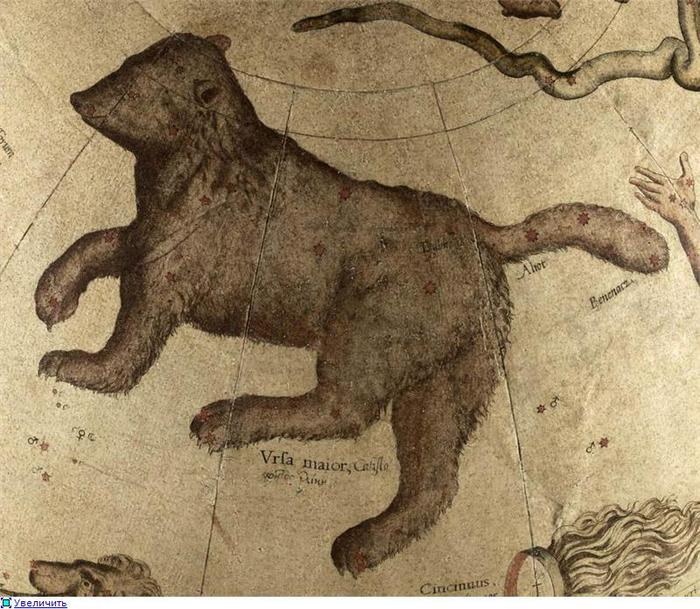
What should we call you, seven stars of the North?
The Big Dipper is shaped like an ancient chariot. The movement of the constellation further increases this similarity. The ancestors of the Gauls called it Arthur's Chariot. In France and in various European countries it was called the Chariot of David. The Romans gave it the name Plaustrum - a “cart” pulled across the sky by three bulls, and in Great Britain this constellation was compared to a plow.
For the Egyptians, the Ursa Major Dipper represents the ship of Isis - the tomb of the Mother, the bearer of life. This ship of destiny sails through the sky, guided by three Egyptian deities. He is led along the star roads by Anubis (the outermost star of the Handle of the Bucket - Benetnash), followed by Isis with the baby Horus in her arms (the famous star couple - Alcor and Mizar) and Nephthys (Aliot). In the Dendera zodiac, the Big Dipper is represented in the guise of a pregnant female hippopotamus - the goddess Taurt.
For the Evenks, the sky is the taiga of the upper world, in which the cosmic Elk Heglun lives, every evening carrying the Sun into the thicket of the taiga. The Big Dipper's bucket is Haglun's legs, and the three stars are hunters or the mythological Manga bear hunting Elk. Ursa Minor is the calf of the Elk, the Milky Way is the traces of a bear hunter.
The circumpolar page of the Book of Constellations can tell a lot about the times of King Arthur. On it live the star images of the Round Table, and the Crown (the constellation of the Northern Crown), and the sword of Arthur (the conventional form of the constellation Boötes with its brightest star Arcturus), and, of course, the most priceless treasure of the knights, the holy Grail - this is our famous Big Dipper Ursa.
You know, Ursa Major keeps another secret. Ancient legend says that Zeus himself fed from the star Buckets. Listen here. At the beginning of time, when the Titans still ruled the world, the Great Mother Goddess Rhea, fearing Kronos, who devoured his children, hid the newborn Zeus in a cave. There he was nursed by a goat, Amalthea, and two she-bears, Melissa and Helis. Subsequently, the great Zeus thanked them by placing them in the very center of the sky. So, since then, the Nurse Bears have lived in the sky, and their star Buckets keep the memory of this. What did they feed God? What's there in these star Buckets?
A blanket of stars spread over the world, flickering with countless lights that never went out. They are always looking down, waiting for us to look at them and remember...
- Happened! I looked into the heavenly bucket and seemed to quench my thirst with star legends!
- Yes, the heart also needs water...
The most noticeable and well-known constellation to everyone without exception is, of course, the Big Dipper. More precisely, it is not itself that is clearly visible in the night sky, but part of it - Big Dipper. If you look closely, you can see several more stars below and to the right of it, making up the paws and head of the Ursa. The shape of this constellation is really very fascinating. After all, no one has ever seen bears with such long tails.
The most visible part of the constellation
Quantity bright stars in the Big Dipper bucket is clear to everyone. There are exactly seven of them. These stars were named by Arab astrologers back in the Middle Ages.
To our ears their “names” actually sound strange:
- Merak.
- Mizar.
- Fegda.
- Megrets.
- Dubge.
- Alioth.
- Benetnash.
From the earth, these stars appear equidistant. In fact, this is far from the case. The number of bright stars in the Big Dipper bucket is seven and they are all not at equal distances from the Earth and the Sun.
Benetnash is located closest to our planet. The farthest star, Alioth, is sixty light years away. However, it looks brighter than Benetnash. This is the brightest and most brilliant object of the Bucket. In terms of the apparent intensity of the emitted light, all the stars in this part of the Big Dipper are close to 2nd magnitude stars.
Noteworthy facts
If you look very closely at one of the stars of the Bucket - Mizar, you can see a faint flicker right next to it. This is explained very simply. Mizar is not an ordinary star, but a double one.
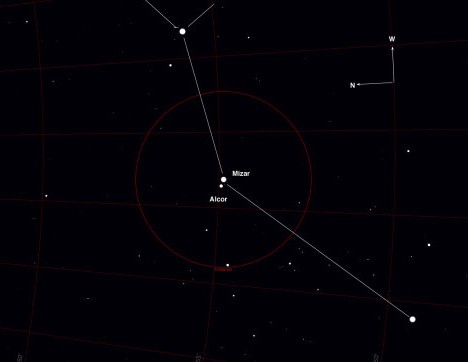
The object located right next to it is called Alcor. From Arabic these two words are translated as “Horse” and “Rider”. Alcor and Mizar are one of the most visible double stars from Earth.
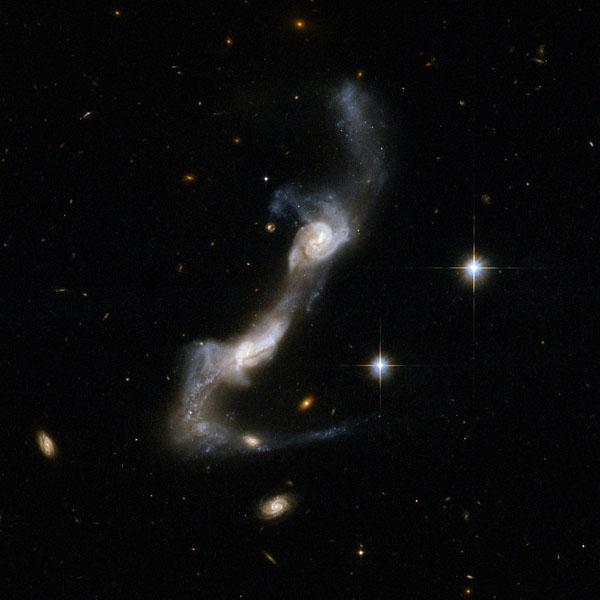
The number of bright stars in the Ursa Major bucket is seven. However, if you look at it through binoculars or a telescope, you can see two more small smears of light. Unlike stars, they look fuzzy and blurry. This is how distant galaxies look from Earth. Located inside the Ursa are called Whirlpool and Pinwheel.
Rotation of the Huge Bucket
The fact that our Earth does not stand still is clear to any schoolchild. Due to its movement, it seems that the stars in the sky are spinning. Kovsh is no exception in this regard. In winter and autumn, Ursa Major is located in the northern part of the night sky, not too high from the horizon. In spring and summer, this most noticeable constellation can be seen almost at its zenith. Moreover, at this time of year the Big Dipper looks upside down.
Celestial compass
So, the number of bright stars in the Ursa Major bucket is exactly seven. Two of them can serve as reference points for those on the move. The fact is that using them it is easy to detect the most famous star in the world - Polaris. This is not difficult to do. You just need to draw an imaginary line along the two outer stars of the Ladle bowl. Next, you should measure approximately the distance between them. The North Star itself is located almost above the northernmost pole.
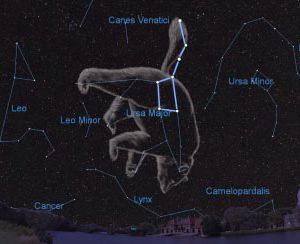
In ancient times, when there were no navigational instruments yet, it served as a guide for all sailors and travelers. So, if you suddenly find yourself in a difficult situation in an unfamiliar area, look at the constellation Ursa Major. The polar star found from it will show you the way to the north. This small and not too bright celestial object has rescued those lost in the taiga, desert or sea more than once. The North Star leads Ursa Major's closest neighbor, Ursa Minor. The location of both of these “animals” is considered circumpolar according to the systematization of astrologers.
How many stars are there in Ursa Major?
Of course, there are even more stars in this constellation itself than in its most noticeable part - the Bucket. At the moment, there are about 125 of them. This is over a hundred bright objects, against the background of which the Sun would look like a small and dim luminous point. The closest star to Earth, unfortunately, is not even visible to the naked eye. It also doesn't have a name. According to astronomical systematization, it passes as a 7.5 m star. Light from it travels approximately 8.25 years to Earth. This is almost twice as much as from the closest star to us - Alpha Centauri. Thus, the answer to the question of how many stars are in Ursa Major is simple - more than a hundred and not all of them are visible without a telescope or binoculars. To spot a feral animal with a long tail in the Bucket, you actually need to have a pretty rich imagination.
The Legend of Ursa Major
Of course, there simply cannot be many different kinds of myths and legends about such noticeable objects of the night sky as the stars of the constellation Ursa Major. The most popular legend about her was invented by the Greeks. The chroniclers of this old country say that once upon a time the king of Arcadia had an unusually beautiful daughter, Callisto. And this woman was so proud of her attractiveness that she dared to compete with Hera herself, the wife of Zeus. The enraged goddess, using her mystical power, of course, took revenge on the proud woman, turning her into a bear. Callisto's son Arkas, who was returning from a hunt at that time, saw a wild animal at the door of the palace and decided to kill it. However, at the last moment he was stopped by Zeus himself, who was not indifferent to the beauty. After being rescued, Callisto was raised to heaven. The stars of the Ursa Major bucket are what she is. At the same time, the supreme god raised the beauty’s beloved dog to heaven. Nowadays it is known under the name Ursa Minor.
Nearest constellations
The stars in the constellation Ursa Major, or rather in its Bucket, are the most noticeable in the night sky. However, in addition to Ursa Minor, there are several other recognizable constellations in the area. The same Polar Star can become a reference point for finding one of them. Behind it, on the opposite side from the Big Dipper, at approximately the same distance, flaunts Cassiopeia, familiar to many by name. From the outside, this constellation looks like the Russian letter “M”. At certain positions of the Earth, Cassiopeia “turns over” and takes the form of a Latin W.
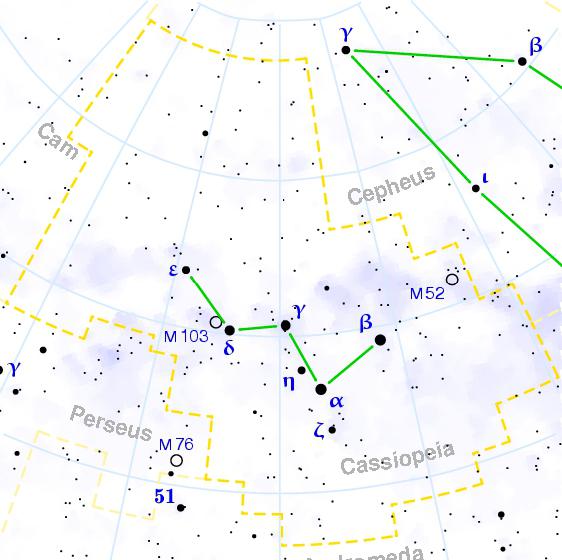
Between her and Ursa Minor and you can see the not so noticeable, but also well-known constellation Cepheus. It does not have a clearly visible form. Between Ursa Major and Ursa Minor it is easy to see the wriggling Dragon. The chain of its stars is easily connected on the map by a broken line.
Well, we hope we have answered the main question of the article about how many luminous permanent objects there are in Ursa Major. There are only seven of them in Kovsh. The main constellation contains about 125 distant “suns”.
> Big Dipper
Big Dipper- one of the most recognizable asterisms. Located in the constellation Ursa Major, it has been imprinted in many cultures under different names. Among the most popular: Plow, Sapta Rishi, Pan. It is especially easy to find in the northern sky in summer. Moreover, they recognize him first of all.
Very often, an asterism is mistaken for the constellation Ursa Major. But the Bucket is not a constellation, but only its most visible part (Ursa Major is in 3rd place in size).
The constellation covers a much larger area than the asterism. But the stars displaying the head, torso, legs and tail are inferior in brightness to those 7 to the brightest stars, located in the back and tail (asterism).
Stars
The seven stars of the Big Dipper are Alkaid (Eta), Mizar (Zeta), Alioth (Epsilon), Megrets (Delta), Phecda (Gamma), Dubhe (Alpha) and Merak (Beta).
Alkaid, Mizar and Alioth mark the handle of the Great Dipper, and Megrets, Phekda, Dubhe and Merak mark the bowl.
The brightest is Aliot, which is also the first brightest in the constellation and the 31st in the sky. Five of the seven are in the Ursa Major Moving Group of stars (Collinder 285): Mizar, Aliot, Megrets, Phekda and Merak. They have the same origin and share motion and speed in space.
Alkaid– a young blue main sequence star (B3V) with an apparent visual magnitude of 1.85 (third in brightness in the constellation) and a distance of 101 light years. 6 times more massive than the Sun and 700 times brighter.
She is also called Benetnash, which is translated from Arabic as “leader of the mourners.” Located at the tip of the Bucket handle (tip of the tail).
Mizar(from the Arabic mīzar - “belt”) is a double star (two double stars) with an apparent magnitude of 2.23 and a distance of 82.8 light years. It became the first double star to be photographed in 1857.
Aliot(from Arabic - “thick tail of sheep”) - a star (A0pCr) with a visual magnitude of 1.76 and a distance of 81 light years. Shows changes in spectral lines with a period of 5.1 days. It is the brightest of the 7 stars in the asterism. Located in the tail, closer to the body.

Megrets(from Arabic – “base of the tail”) – white dwarf main sequence star (A3V) with an apparent visual magnitude of 3.312 (the faintest of the seven) and a distance of 58.4 light years. 63% more solar mass and 14 times brighter.
Fekda(from Arabic - “thigh of the bear”) is a main sequence white dwarf (A0Ve) with an apparent magnitude of 2.438 and a distance of 83.2 light years.
Dubhe(from Arabic - “bear”) - an orange giant (K1II-III) with a visual magnitude of 1.79 (second in brightness) and a distance of 123 light years. It is a spectroscopic binary star with a companion, a yellow-white main sequence star (F0V). They are separated by a distance of 23 AU, and the orbital period is 44.4 years.
Merak(from Arabic - “lower back”) is a white main sequence star (A1V) with an apparent magnitude of 2.37 and a distance of 79.7 light years. This is a suspicious variable star, whose mass is 2.7 times that of the Sun and 68 times brighter.
Facts and location
Ursa Major covers the second quadrant of the northern hemisphere (NQ2). It can be found in latitudes from +90° to -30°. The best visibility is provided in April. The asterism is circumpolar in most regions of the northern hemisphere (does not fall below the horizon). As the planet rotates, the constellation appears to move slowly counterclockwise around the north celestial pole.
IN different time year, the Big Dipper appears in various parts of the sky. In spring and summer it is high, and in autumn and winter it is closer to the horizon. The appearance of an asterism can vary greatly. So in the fall it seems that it is resting on the horizon, in the winter the handle dangles from the bowl, in the spring it turns over, and in the summer the bowl is inclined closer to the ground.
![]()
The Big Dipper is located in an area that contains several notable celestial objects. Among them: Whirlpool Galaxy (), Pinwheel Galaxy (), double star, spiral galaxy (Bode Galaxy), irregular galaxy (Cigar), planetary nebula (Owl Nebula) and spiral galaxies and.
Asterism plays an important role in the search for other notable stars. You can find (Bootes) by the handle, then the line will lead to (Virgo). The two stars forming the bowl will point to the North Star, and Megrets and Phecda will point to Regulus (Leo), which is also one of the brightest stars in the sky, and Alphard (Hydra). The line from Megrets to Dubha points the way to (Auriga), and from Megrets to Merak - to Castor (Gemini).
In 50,000 years, the stars of the Big Dipper will change their position, and therefore change the shape of the asterism (turn in the opposite direction). But, since most of them are included in the Moving Group of Ursa Major stars (except for Alkaid and Dubhe), the pattern will not change dramatically. This picture will remain the same after 100,000 years, but the handle will still transform.
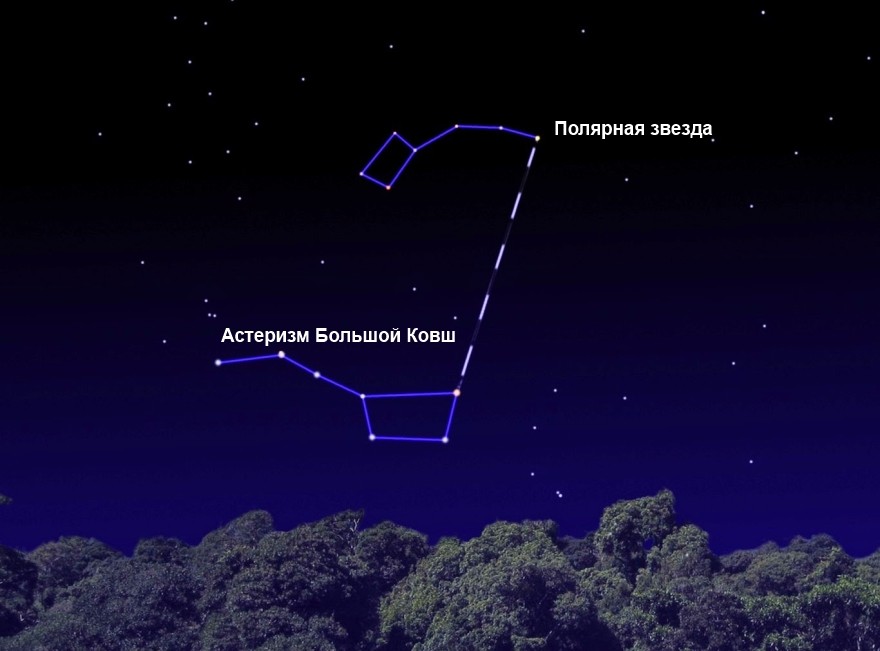
If you find the Big Dipper, then finding the North Star is a matter of seconds. It is located in Ursa Minor. The Big Dipper rotates around the north pole and always points towards the North Star.
The Small Bucket is located close to the Big Bucket. But its stars are much fainter, making them difficult to find, especially in places where there is a lot of city light. Therefore, it is easier to use the stars of the Big Dipper to help find the North Star and North. To do this, you need to follow the stars Merak and Dubhe (end of the bowl). Just follow the line until you come across a bright star. They are called pointer stars. But after the Polar Star you can also find the Small Dipper, since the star is located at the end of its handle (tail).
Myth
The Big Dipper combines many myths and folk legends from all over the world. The Hindus call the asterism Sapta Rishi (Seven Great Sages), in East Asia - the Northern Dipper, in China - Tseikh Sing, in Malaysia - Burudj (Biduk), in Mongolia - the Seven Gods. In Arab history, the stars forming a bowl represented the coffin, and the three stars represented the mourners following it. The name "Alkaid" refers to this story.
In Great Britain and Ireland it is called the Plow, and sometimes the Butcher's Knife (northern parts of England). Once upon a time in England it was called Charles Wayne (carriage). Moreover, it is interesting that the Big Dipper marks the masculine, and the Small – the feminine.
For the Slavs and Romanians it is the Big Cart, and for the Germans it is the Great Cart. The Romans believed that there were “seven oxen” in front of them, where only two stars depicted bulls, and the rest - a cart. In some Native American tribes it was about three hunters chasing a bear. They associated this with autumn and explained why the leaves begin to turn red. The fact is that they are stained with blood from the wounds of the animal (at this time the asterism is below its normal position).
